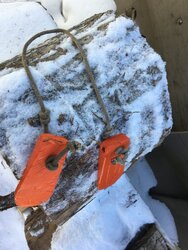Grapple for the Kubota:
- pick up logs for transport, no dragging through the dirt; don't even have to get out of the seat.
- pick up logs to cut at waist level, both for delimbing and bucking; far safer no more pinching (watch your toes!); far easier and far better on your back
Downside: You have to buy the grapple ($700-$2000) and you have a third function on your tractor and FEL.
Upside: The grapple is one of the most useful tractor implements you can own and use.
- pick up logs for transport, no dragging through the dirt; don't even have to get out of the seat.
- pick up logs to cut at waist level, both for delimbing and bucking; far safer no more pinching (watch your toes!); far easier and far better on your back
Downside: You have to buy the grapple ($700-$2000) and you have a third function on your tractor and FEL.
Upside: The grapple is one of the most useful tractor implements you can own and use.



